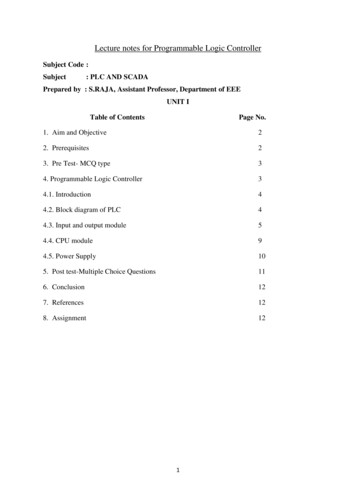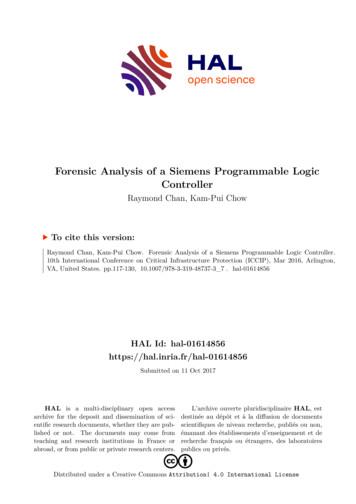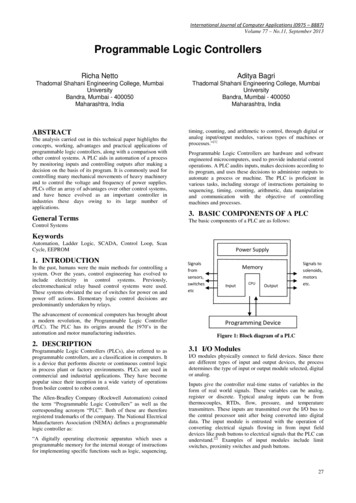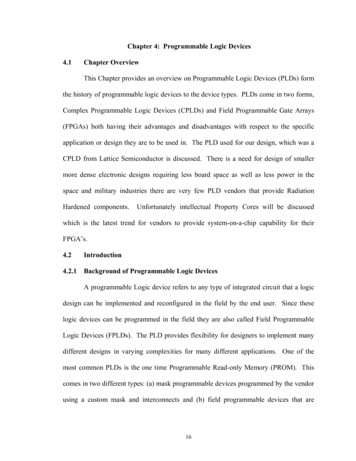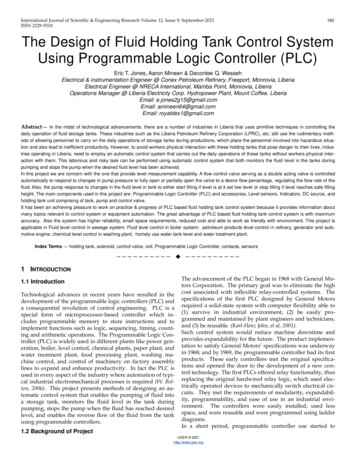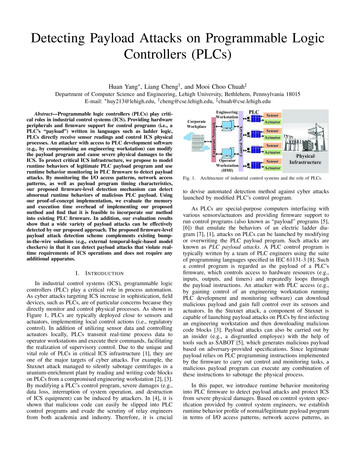
Transcription
Study and Implementation of Programmable Logic controllerA THESIS SUBMITTED IN PARTIAL FULFILLMENTOF THE REQUIREMENTS FOR THE DEGREE OFBachelor of TechnologyinElectronics & Instrumentation EngineeringByP.ABINANDHANRoll No: 10307033RAJEEV NAYAN PRAKASHRoll No: 10407014RABINDRA KUMAR SAMADRoll No: 10407027Department of Electronics & Communication EngineeringNational Institute of Technology, RourkelaRourkela, Orissa–7690082008
Study and Implementation of Programmable Logic controllerA THESIS SUBMITTED IN PARTIAL FULFILLMENTOF THE REQUIREMENTS FOR THE DEGREE OFBachelor of TechnologyinElectronics & Instrumentation EngineeringByP.ABINANDHANRoll No: 10307033RAJEEV NAYAN PRAKASHRoll No: 10407014RABINDRA KUMAR SAMADRoll No: 10407027Under the Guidance ofProf. T.K.DANDepartment of Electronics & Communication EngineeringNational Institute of Technology, RourkelaRourkela, Orissa – 76900820082
NATIONAL INSTITUTE OF TECHNOLOGYROURKELACERTIFICATEThis is to certify that the thesis titled, “Study and Implementation of ProgrammableLogic Controller” submitted by P.Abinandhan (Roll No: 10307033), Rajeev NayanPrakash (Roll No: 10407014) and Rabindra Kumar Samad (Roll No: 10407027) inpartial fulfillment for the award of Bachelor of Technology degree in Electronics andInstrumentation Engineering, National Institute of Technology, Rourkela is anauthentic work carried out by them under my supervision and guidance.To the best of my knowledge, this matter embodied in the thesis has not been submittedat any other university / institute for the award of any Degree or Diploma.Professor T.K.DANDepartment of Electronics &Communication EngineeringNational Institute of TechnologyRourkela – 769008.3
ACKNOWLEDGEMENTI would like to extend my gratitude & my sincere thanks to our guide Prof. T.K.Dan,Department of Electronics and Communication Engineering for his valuable guidance,constant encouragement and kind help at different stages for the execution of thisdissertation work. I would also like to thank the staff at the Transducer andInstrumentation lab for allowing us to carry out our project work in the lab.We also express our sincere gratitude to Prof. G.Panda, Head of the Department,Electronics and Communication Engineering, for providing us with this project andvaluable departmental facilities.I would like to thank my teachers and friends for their cooperation in carrying out theproject.P.AbinandhanRoll No – 10407010NIT, RourkelaRajeev Nayan PrakashRabindra Kumar SamadRoll No – 10407014Roll No - 10407027NIT, RourkelaNIT,Rourkela4
CONTENTSTOPICPgs.1. Abstract62. Introduction to Programmable Logic Controllers 73. History of PLCs 7-84. Characteristics .85. System Scale .96. Programming in PLCs . 9-107. User Interface . 108. How does a PLC operate?. 10-119. Other auxiliary devices connected to a PLC . 12-1310. PLCs as compared to other control systems . 1411. Digital and Analog signals . 15-1612. PLC Software . 1613. PLC Applications 17-2014. Lift Control ModuleIntroduction .21Hardware 22-24Lift control Using PLC With Explanation .24-2915. Temperature Control TrainerIntroduction .30-31Description of The Instrument .32-335
Temperature control Programs With ExplanationFor Single and Dual Set Point 33-3616. Liquid level control TrainerIntroduction 37Description of the Instrument .38Liquid level control program with explanation .39-4017. Conclusion .4118. Bibliography .426
ABSTRACTThis project work is divided into two parts. The first part deals with the history anddevelopment of Programmable Logic Controllers and its subsequent applications indifferent industries. In The second part PLC was implemented to control 3 differentprocesses namely lift car controller, Liquid level controller, Temperature controller.Automation of many different processes, such as controlling machines or factoryassembly lines, is done through the use of small computers called a programmable logiccontroller (PLC). This is actually a control device that consists of a programmablemicroprocessor, and is programmed using a specialized computer language.Before, a programmable logic controller would have been programmed in ladder logic,which is similar to a schematic of relay logic. A modern programmable logic controller isusually programmed in any one of several languages, ranging from ladder logic to Basicor C. Typically, the program is written in a development environment on a personalcomputer (PC), and then is downloaded onto the programmable logic controller directlythrough a cable connection. The program is stored in the programmable logic controllerin non-volatile memory.The programmable logic controller has made a significant contribution to factoryautomation. Earlier automation systems had to use thousands of individual relays andcam timers, but all of the relays and timers within a factory system can often be replacedwith a single programmable logic controller. Today, programmable logic controllersdeliver a wide range of functionality, including basic relay control, motion control,process control, and complex networking, as well as being used in Distributed ControlSystems.There are several different types of interfaces that are used when people need to interactwith the programmable logic controller to configure it or work with it. This may take theform of simple lights or switches or text displays, or for more complex systems, acomputer of Web interface on a computer running a Supervisory Control and DataAcquisition (SCADA) system.Programmable logic controllers were first created to serve the automobile industry, andthe first programmable logic controller project was developed in 1968 for General Motorsto replace hard-wired relay systems with an electronic controller.The lift controller controls the movement of the lift. The program is designed to make thelift car move to the correct floor based on floor request. The temperature controllercontrols the temperature of the fluid based on a set point. The level controller controls thelevel of a liquid in a tank.7
IntroductionFast and Easy PLC Control The object of a PLC simulator is to 'fake out' the input into aPLC so that the programmer can test and debug the program before installation into it'soperating environment. Our patent pending PLC simulators achieve this by mounting onthe existing terminal strip of the PLC card and providing easy controls to turn digitalinputs on/off or adjust analog signals. If you are a engineer who programs PLCs or even atechnician in need of a quick way to test a PLC functionality then these devices are foryou. Save time, money and embarrassment by fixing problems before they start. ThesePLC simulators are for sale in our products section.HistoryThe PLC was invented in response to the needs of the American automotive industry.Before the PLC, control, sequencing, and safety interlock logic for manufacturingautomobiles was accomplished using relays, timers and dedicated closed-loop controllers.The process for updating such facilities for the yearly model change-over was very timeconsuming and expensive, as the relay systems needed to be rewired by skilledelectricians. In 1968 GM Hydramatic (the automatic transmission division of GeneralMotors) issued a request for proposal for an electronic replacement for hard-wired relaysystems.The winning proposal came from Bedford Associates of Bedford, Massachusetts. Thefirst PLC, designated the 084 because it was Bedford Associates eighty-fourth project,was the result. Bedford Associates started a new company dedicated to developing,manufacturing, selling, and servicing this new product: Modicon, which stood forModular Digital Controllers. One of the people who worked on that project was DickMorley, who is considered to be the "father" of the PLC. The Modicon brand was sold in1977 to Gould Electronics, and later acquired by German Company AEG and then byFrench Schneider Electric, the current owner.One of the very first 084 models built is now on display at Modicon's headquarters inNorth Andover, Massachusetts. It was presented to Modicon by GM, when the unit wasretired after nearly twenty years of uninterrupted service.The automotive industry is still one of the largest users of PLCs, and Modicon stillnumbers some of its controller models such that they end with eighty-four. PLCs are used8
in many different industries and machines such as packaging and semiconductormachines. Well known PLC brands are Siemens, Allen-Bradley, ABB, Mitsubishi,Omron, and General Electric.CharacteristicsThe main difference from other computers is that PLCs are armored for severe condition(dust, moisture, heat, cold, etc) and have the facility for extensive input/output (I/O)arrangements. These connect the PLC to sensors and actuators. PLCs read limit switches,analog process variables (such as temperature and pressure), and the positions of complexpositioning systems. Some even use machine vision. On the actuator side, PLCs operateelectric motors, pneumatic or hydraulic cylinders, magnetic relays or solenoids, or analogoutputs. The input/output arrangements may be built into a simple PLC, or the PLC mayhave external I/O modules attached to a computer network that plugs into the PLC.PLCs were invented as replacements for automated systems that would use hundreds orthousands of relays, cam timers, and drum sequencers. Often, a single PLC can beprogrammed to replace thousands of relays. Programmable controllers were initiallyadopted by the automotive manufacturing industry, where software revision replaced there-wiring of hard-wired control panels when production models changed.Many of the earliest PLCs expressed all decision making logic in simple ladder logicwhich appeared similar to electrical schematic diagrams. The electricians were quite ableto trace out circuit problems with schematic diagrams using ladder logic. This programnotation was chosen to reduce training demands for the existing technicians. Other earlyPLCs used a form of instruction list programming, based on a stack-based logic solver.The functionality of the PLC has evolved over the years to include sequential relaycontrol, motion control, process control, distributed control systems and networking. Thedata handling, storage, processing power and communication capabilities of somemodern PLCs are approximately equivalent to desktop computers. PLC-likeprogramming combined with remote I/O hardware, allow a general-purpose desktopcomputer to overlap some PLCs in certain applications.Under the IEC 61131-3 standard, PLCs can be programmed using standards-basedprogramming languages. A graphical programming notation called Sequential FunctionCharts is available on certain programmable controllers.9
System Scale:A small PLC will have a fixed number of connections built in for inputs and outputs.Typically, expansions are available if the base model does not have enough I/O.Modular PLCs have a chassis (also called a rack) into which is placed modules withdifferent functions. The processor and selection of I/O modules is customised for theparticular application. Several racks can be administered by a single processor, and mayhave thousands of inputs and outputs. A special high speed serial I/O link is used so thatracks can be distributed away from the processor, reducing the wiring costs for largeplants.PLCs used in larger I/O systems may have peer-to-peer (P2P) communication betweenprocessors. This allows separate parts of a complex process to have individual controlwhile allowing the subsystems to co-ordinate over the communication link. Thesecommunication links are also often used for HMI (Human-Machine Interface) devicessuch as keypads or PC-type workstations. Some of today's PLCs can communicate over awide range of media including RS-485, Coaxial, and even Ethernet for I/O control atnetwork speeds up to 100 Mbit/s.Programming in PLCsEarly PLCs, up to the mid-1980s, were programmed using proprietary programmingpanels or special-purpose programming terminals, which often had dedicated functionkeys representing the various logical elements of PLC programs. Programs were storedon cassette tape cartridges. Facilities for printing and documentation were very minimaldue to lack of memory capacity. More recently, PLC programs are typically written in aspecial application on a personal computer, then downloaded by a direct-connection cableor over a network to the PLC. The very oldest PLCs used non-volatile magnetic corememory but now the program is stored in the PLC either in battery-backed-up RAM orsome other non-volatile flash memory.Early PLCs were designed to replace relay logic systems. These PLCs were programmedin "ladder logic", which strongly resembles a schematic diagram of relay logic. ModernPLCs can be programmed in a variety of ways, from ladder logic to more traditionalprogramming languages such as BASIC and C. Another method is State Logic, a VeryHigh Level Programming Language designed to program PLCs based on State TransitionDiagrams.10
Recently, the International standard IEC 61131-3 has become popular. IEC 61131-3currently defines five programming languages for programmable control systems: FBD(Function block diagram), LD (Ladder diagram), ST (Structured text, similar to thePascal programming language), IL (Instruction list, similar to assembly language) andSFC (Sequential function chart). These techniques emphasize logical organization ofoperations.While the fundamental concepts of PLC programming are common to all manufacturers,differences in I/O addressing, memory organization and instruction sets mean that PLCprograms are never perfectly interchangeable between different makers. Even within thesame product line of a single manufacturer, different models may not be directlycompatible.User InterfacePLCs may need to interact with people for the purpose of configuration, alarm reportingor everyday control. A Human-Machine Interface (HMI) is employed for this purpose.HMI's are also referred to as MMI's (Man Machine Interface) and GUI (Graphical UserInterface).A simple system may use buttons and lights to interact with the user. Text displays areavailable as well as graphical touch screens. Most modern PLCs can communicate over anetwork to some other system, such as a computer running a SCADA (SupervisoryControl And Data Acquisition) system or web browser.How does a PLC operate?There are four basic steps in the operation of all PLCs; Input Scan, Program Scan, OutputScan, and Housekeeping. These steps continually take place in a repeating loop.Four Steps In the PLC Operations1.) Input ScanDetects the state of all input devices that are connected to the PLC2.) Program ScanExecutes the user created program logic.3.) Output ScanEnergizes or de-energize all output devices that are connected to the PLC.4.) HousekeepingThis step includes communications with programming terminals, internaldiagnostics, etc11
Fig.Operation of a PLC in basic stages12
Other Auxiliary devices connected To a PLC:Input devices:– Condition Sensors– Encoders Pressure Switches Level Switches Temperature Switches Vacuum Switches Float Switches- Switches and Pushbuttons– Sensing Devices Limit Switches Photoelectric Sensors and proximity sensors13
Output Devices– Valves– Motor Starters– Solenoids– Actuators– Horns and Alarms– Stack lights– Control Relays– Counter/Totalizers– Pumps– Printers– Fans14
PLCs as compared to the other control Systems:PLCs are well-adapted to a range of automation tasks. These are typically industrialprocesses in manufacturing where the cost of developing and maintaining the automationsystem is high relative to the total cost of the automation, and where changes to thesystem would be expected during its operational life. PLCs contain input and outputdevices compatible with industrial pilot devices and controls; little electrical design isrequired, and the design problem centers on expressing the desired sequence ofoperations in ladder logic (or function chart) notation. PLC applications are typicallyhighly customized systems so the cost of a packaged PLC is low compared to the cost ofa specific custom-built controller design. On the other hand, in the case of mass-producedgoods, customized control systems are economic due to the lower cost of thecomponents, which can be optimally chosen instead of a "generic" solution, and wherethe non-recurring engineering charges are spread over thousands of places.For high volume or very simple fixed automation tasks, different techniques are used. Forexample, a consumer dishwasher would be controlled by an electromechanical cam timercosting only a few dollars in production quantities.A microcontroller-based design would be appropriate where hundreds or thousands ofunits will be produced and so the development cost (design of power supplies andinput/output hardware) can be spread over many sales, and where the end-user would notneed to alter the control. Automotive applications are an example; millions of units arebuilt each year, and very few end-users alter the programming of these controllers.However, some specialty vehicles such as transit busses economically use PLCs insteadof custom-designed controls, because the volumes are low and the development costwould be uneconomic.Very complex process control, such as used in the chemical industry, may requirealgorithms and performance beyond the capability of even high-performance PLCs. Veryhigh-speed or precision controls may also require customized solutions; for example,aircraft flight controls.PLCs may include logic for single-variable feedback analog control loop, a "proportional,integral, derivative" or "PID controller." A PID loop could be used to control thetemperature of a manufacturing process, for example. Historically PLCs were usuallyconfigured with only a few analog control loops; where processes required hundreds orthousands of loops, a distributed control system (DCS) would instead be used. However,as PLCs have become more powerful, the boundary between DCS and PLC applicationshas become less clear-cut15
Digital and Analog Signals:Digital or discrete signals behave as binary switches, yielding simply an On or Off signal(1 or 0, True or False, respectively). Pushbuttons, limit switches, and photoelectricsensors are examples of devices providing a discrete signal.Discrete signals are sent using either voltage or current, where a specific range isdesignated as On and another as Off. For example, a PLC might use 24 V DC I/O, withvalues above 22 V DC representing On, values below 2VDC representing Off, andintermediate values undefined. Initially, PLCs had only discrete I/O.Analog signals are like volume controls, with a range of values between zero and fullscale. These are typically interpreted as integer values (counts) by the PLC, with variousranges of accuracy depending on the device and the number of bits available to store thedata. As PLCs typically use 16-bit signed binary processors, the integer values are limitedbetween -32,768 and 32,767.Pressure, temperature, flow, and weight are often represented by analog signals. Analogsignals can use voltage or current with a magnitude proportional to the value of theprocess signal. For example, an analog 4-20 mA or 0 - 10 V input would be convertedinto an integer value of 0 - 32767.Current inputs are less sensitive to electrical noise (i.e. from welders or electric motorstarts) than voltage inputs.As an example, say the facility needs to store water in a tank.The water is drawn from the tank by another system, as needed, and our example systemmust manage the water level in the tank.Using only digital signals, the PLC has two digital inputs from float switches (tank emptyand tank full). The PLC uses a digital output to open and close the inlet valve into thetank. When the water level drops enough so that the tank empty float switch is off(down), the PLC will open the valve to let more water in. Once the water level raisesenough so that the tank full switch is on (up), the PLC will shut the inlet to stop the waterfrom overflowing. Low LevelHigh LevelFill Valve ------[/]------ ------[/]----------------------(OUT)--------- Fill Valve ------[ ]------ 16
An analog system might use a water pressure sensor or a load cell, andan adjustable (throttling)dripping out of the tank, the valve adjuststo slowly drip water back into the tank.In this system, to avoid 'flutter' adjustments that can wear out the valve, many PLCsincorporate "hysteresis" which essentially creates a "deadband" of activity. A technicianadjusts this dead band so the valve moves only for a significant change in rate. This willin turn minimize the motion of the valve, and reduce its wear.A real system might combine approaches, using float switches and simple valves toprevent spills, and a rate sensor and rate valve to optimize refill rates and prevent waterhammer. Backup and maintenance methods can make a real system very complicated.PLC Software:The PLC software is manufacturer dependent and even when the manufacturer is thesame, it may vary for the different models of the same brand.For, instance for a manufacturer like Allen Bradley the software may vary for its PICOController models and other models. For example, the software used for these controllersis PICOSoft whereas for its higher models it is RSLogix.Moreover, the HMI Interface may also vary for the different controllers.17
PLC APPLICATIONS:Automotive IndustryReducing Time-To-Customer and Other CostsThe automotive landscape is changing. Emerging markets are forcing you to re-thinkproduction strategies. The effects of a tight economy and intense competition means youneed suppliers to play a larger role in successfully executing the supply chain.Our industrial automation and control solutions span the entire automotive supply chainand can help you address these challenges while staying focused on improving quality,reducing costs, increasing responsiveness and ultimately improving time-to-customerthroughout your supply chain.By combining our integrated architecture with proven automotive manufacturingsolutions, you get accurate, event-driven information about materials, operations andfinished-product requirements — and the ability to deliver and receive the rightcomponents, in the right quantities, at exactly the right time and place. The result: fastertime-to-customer for the entire industry.Your requirements are unique. So are our solutions. We listen to you then apply ourresources to build cost-effective, results-based solutions for the automotive industry. Weare committed to your success. Whatever your automation challenges, you'll find theanswer by partnering with us.Beverage IndustryImproving Production Flexibility and AgilityYou are striving for consistent quality regardless of where your product is manufacturedor distributed, while under continuous pressure to respond quicker than your competitorsto changes in consumer demand during continued consolidation in the industry.Our focus on beverage production optimization addresses these issues and every phase ofyour operation so you can meet cost, quality, flexibility and regulatory challenges acrossthe entire life cycle - from raw materials through final shipment.18
Because of the diversity of beverage production processes, it can be challenging for youto meet customer demand, document regulatory compliance and identify productioninefficiencies. Through our domain knowledge and production experience, we offer avariety of solutions to help you satisfy your demanding consumers and retailers.We understand the beverage industry, and can help you turn our solutions and servicesinto a competitive advantage. Your requirements are unique, so whatever productionchallenges you have, partnering with us will help you overcome them.Entertainment IndustryIncreasing the Safety, Reliability and Profitability ofYour VenueWhether we're controlling a roller coaster racing at 120 miles per hour, protecting aninvestment in valuable exotic creatures, or providing secure transportation to ski runs, ourcomponents and systems meet your automation challenges to increase your safety,reliability and profitability.From the initial conceptualization of the system architecture through the implementationand commissioning of a specific solution, we will receive the skills and experience tofulfill your project requirements through: Superior support, everything from integrated engineering and support solutions onmulti-vendor platforms, to software and MRO asset management services.Global parts availability for localized support.Depth and breadth of products.Migration with easy upgrades to the newest technology to protect your investmentlong-term.Essential Components with exceptional value to give you the assurance that themachines and systems you build will have the optimum levels of quality andperformance.Integrated Architecture for seamless integration of control, communication, andvisualization across multiple platforms.Marine IndustryOptimize Equipment Performance and ImproveReliabilityOperational demands are placing enormous pressure to optimize reliability and safetywhile reducing the size and weight of equipment.19
Improving onboard capabilities with a common shipboard architecture that provides shipwide control and visualization, and commercial off-the-shelf (COTS) technology forapplications and equipment that offer you: Durability to confidently withstand the shipboard environment (shock, vibration,EMI)Reliability measured by high Mean Time Before Failure (MTBF) statisticsExpandability to grow with and develop future applicationsGlobal support and local material availabilityApplying the right combination of predictive, preventive and reactive maintenancemethods to optimize equipment performance and improve reliability.Packaging IndustryDeliver Greater Speed and Accuracy to Meet UrgentDemandsFiercely competitive markets are driving your customers to offer an exhaustive breadth ofproducts. That means packaging equipment must be flexible enough to keep up withfrequent line changes and scalable enough to handle the introduction of new products.At the same time, customers demand customization with greater speed and accuracy —and shortened lead times.We help you meet these challenges through a single hardware and software solution andprogramming templates and tools.Everything we offer, from components to turnkey systems, is designed to save time andreduce your customers' total cost of ownership. And our support doesn't stop there.Through remote diagnostics, predictive maintenance and a network of global support, wecan help your customers — no matter where they put their packaging machines to work.Intelligent Motor ControlMotor Control ApplicationsVariable Speed ControlImprove your process performance with precise speed and torque control and save moneywith energy efficient operation.20
PowerFlex Family of AC DrivesBecause we have a wide range of control needs, PowerFlex AC drives offer a variety ofmotor control technologies, from Volts/Hertz Control for the simplest applications, toVector Control with patented FORCE Technology, which provides excellent lowspeed/zero speed performance for both induction and permanent magnet motors. Formotor control applications from low to medium voltage, and from simple to complex, thePowerFlex family of drives range from 0.2 kW (0.25 hp) to 25.4 MW (34000 hp).21
LIFT CONTROL MODULE1) IntroductionThis trainer is intended to demonstrate the operation of a Lift car using a PLC. Using thistrainer one can understand the concepts of data logging and the control operation of Liftcontrol system. There are various types of controllers to do the control action. Here weare using a PLC to achieve this. This trainer has all the necessary instrumentation likeroller switches to sense the position of the lift car, Stepper motor to simulate themovement of the lift either upward or downward directions.Using the hardware available with the setup various types of control actionscan be done using PLC Trainer Model IM-29. In this manual a general LIFT CONTROLPROGRAM is described. Depending upon the logic one can use various programs andtest the control operations.22
2) HARDWARE2.1 Description of the front panel2.2 Hardware description1. Floor sensorsRoller Switches are used as floor sensors. When lift carcrosses the roller, the roller holder moves inside and thepush button will be pressed. The sensor delivers 5Vwhen the push button is pressed. This voltage is givento the TTL Input of the PLC Trainer. Ground Floor andSecond Floor have one roller switch each First Floorfeed back is taken from two roller switches to detectTop and Bottom edges of the Lift Car. This is necessaryto stop the lift car at same position in both directions.2. Lift car setupThe Lift car is fixed to two guide rods to determine the lift car movement in a fixed path.The rods are fixed to the top and the bottom of the lift setup. The rear side of the lift car ismounted on a belt which is connected to the shaft of the Stepper Motor.23
3. Stepper MotorStepper motor is a DC motor. It differs with conventional motors in the sense that steppermotor is used for positioning the rotor at a specified position. A sequential magnetizationand demagnetization enables the rotor of the motor to rotate on its axis by a fixed angle.If this is so it should be possible to rotate only a few steps either in clockwise or anticlockwise direction. For examp
The programmable logic controller has made a significant contribution to factory automation. Earlier automation systems had to use thousands of individual relays and cam timers, but all of the relays and timers within a factory system can often be replaced with a single programmable logic controller. Today, programmable logic controllers

